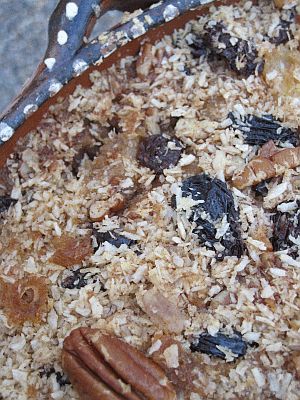Capirotada is a traditional Lenten food that is both a sweet and savory baked desert made from stale bread, piloncillo, cinnamon, raisins, nuts and often, cheese. The name derives from the word Caperuza, ostensibly because its bubbling cap of cheese suggests a friars hood or cowl.
The path to capirotada appears to be rooted in capirote, which derives from capirón referring in particular to cucurucho, which is a cap worn during the Roman Catholic Semana Santa (Easter) processions.
Historical Spanish cookbooks refer to its European predecessor, Sala Cattaba, a mixture of ³bread, liquid, savories such as vegetables, fowl, meat and fat, and a dressing made of mint, pepper, celery, pennyroyal, pine nuts, vinegar, honey, water and cheese² (Armendariz, 2006). As this bread pudding evolved, the meat was taken out of the dish in the late 19th century and it crossed over into the world of sweet desserts.
Food historians suggest that capirotada was invented as a way to use up leftovers before beginning the Lenten fast. The Spanish introduced Capirotata to Mexico along with the wheat, raisins, and cows originally required to make the recipe. These foods fused with indigenous ingredients like coconut and pineapple. Capirotada can include tomatoes, onions, apples, peanuts, almonds, walnuts, pecans, and a choice of cheeses such as Queso Añejo, Ranchero, or Chihuahua.
My neighbor Alisia introduced me to Capirotada many years ago during our cooking seminars, and now we have an annual ritual of sharing this rich pudding together. Indeed while my family loves the chile rellenos, stuffed baked Nopales and Easter fruit salad she prepares, we always save room for her pièce de résistance, which she proudly makes a little differently every time.
Recipe
1.5 cups pineapple juice
1/2 cup water
1 cup piloncillo (grated or broken into small pieces)
3 cups pineapple chunks
2 sticks butter
1/2 tsp cinnamon
1/8 tsp nutmeg
6 stale bolillo (1 inch cubes or pieces)
1 cup raisins
1 cup Pecans or Walnuts - chopped
2 cups coconut meat shredded
6 ounces grated Chihuahua cheese (optional)
Preheat oven to 350 F° (176 C°)
Cut or tear bolillos into cubes or pieces and set aside in a large bowl.
Put the piloncillo in a pan over a low flame with the pineapple juice and water to dissolve. Once dissolved, add the butter, cinnamon and nutmeg and stir until reduced by about half to syrup.
Pour most of the liquid (reserve about a 1/4 cup) over the broken up pieces of stale bollilo and let sit for 20 minutes.
Butter the inside of the capirotada pan, which should be a large clay-baking dish, baking pan or a large casserole dish. (A clay dish will heat more evenly but take about 10 minutes longer to bake through.)
Layer bread pieces, raisins, nuts, pineapple and the shredded coconut repeating until all layers are complete.
Finally, pour the rest of the liquid over the top and sprinkle coconut. Spread the grated cheese over the top covering liberally providing the cap.
Bake at 350 degrees F (176 C) for about 30 minutes. You can test it and it will be moist but not mushy. Serve warm.
 Dr. Leslie Korn is an educator and clinician-healer specializing in complementary/alternative medicine and indigenous healing methods, who has been conducting research in the Banderas Bay and Cabo Corrientes regions since 1973. To learn more about her work, visit DrLeslieKorn.com.
Dr. Leslie Korn is an educator and clinician-healer specializing in complementary/alternative medicine and indigenous healing methods, who has been conducting research in the Banderas Bay and Cabo Corrientes regions since 1973. To learn more about her work, visit DrLeslieKorn.com.Click HERE to read more articles by Leslie Korn.



